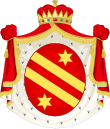Prince of Canino and Musignano
| Prince of Canino and Musignano | |
|---|---|
 | |
| Parent house | House of Bonaparte |
| Founded | 1814 |
| Founder | Lucien Bonaparte |
| Titles | Prince of Canino Prince of Musignano |
ThePrinces of Canino and Musignanoformed the genealogically senior line of theBonapartefamily following the death ofJoseph Bonapartein 1844. The line was succeeded by one ofEmperor Napoleon's younger brothers,Lucien Bonaparte.It became extinct in the male line in 1924. Thedynastic Bonapartistpretendersdescend in the male line from PrinceJérôme Napoléon,Napoleon's youngest brother.
Caninoand Musignano are two neighbouring villages in theProvince of Viterboin Italy. They were bestowed onLucien Bonaparteby papal authority on 18 August 1814 (Prince of Canino) and on 21 March 1824 (Prince of Musignano).
First Empire law
[edit]Article 7 of themonarchicalconstitution of theFirst French Empire,promulgated 20 May 1804, established that upon extinction of the legitimate natural and adopted male,agnaticdescendants of Napoleon I (1769–1821), and those of two of his brothers, PrinceJoseph Napoléon(1768–1844) and PrinceLouis Napoléon(1778–1846), the throne was to be awarded to a man selected by the non-dynastic princely and ducal dignitaries of the empire, as ratified byplebiscite.[1]On 24 September 1806, the emperor's youngest brother, Jérôme Napoléon (1784–1860), was made a French prince, along with the future issue of his second marriage to DuchessCatharina of Württemberg,and he and his heirs were added into the succession.
On 22 March 1815, during theHundred Days,Napoleon also recognized his brother Lucien and Lucien's sons as Imperial French princes. At no time, however, were Lucien and his issue recognized during the First Empire as eligible by law to inherit the French throne, or any other throne. The title ofPrincipe di Canino e Musignanoborne by Lucien and hisheirs malewas apapaltitle of nobility, never legally recognized in France.[2]
Therefore, upon the death without issue in 1832 of theDuke of Reichstadt,titularEmperor Napoleon II,the claim to the Bonaparte crown of France devolved uponJoseph Bonaparte,formerly King of Naples and then King of Spain. Following his death without sons in 1844, the Imperial claim bypassed Lucien's sons and devolved uponLouis Bonaparte,formerly King of Holland, even though Louis had been younger than Lucien.
Second Empire law
[edit]Louis's two elder sons pre-deceased their father, but his third son became EmperorNapoleon IIIin 1852. TheSecond Empire's constitution recognized thedynasticityof all of Napoleon I's brothers and their issue, but allowed the emperor to choose the order in which they would inherit the throne in the event he died without male issue. On 18 December 1852 the emperor appointed his only remaining uncle, Prince Jérôme Napoléon, former King of Westphalia, asheir presumptive,again bypassing the male line of Lucien.
In May 1870, thatorder of successionwas confirmed by referendum, except that PrinceNapoléon Joseph(1822–1891), Jérôme's surviving son by his second wife, Duchess Catharina of Württemberg, was named to follow the emperor's son, the Prince ImperialNapoléon Eugènein the succession line.[3]However, a few months later the French Empire was abolished, and has not been restored. Meanwhile, theagnaticdescendants of Jérôme Napoléon's branch (thePrince Napoléon Line) are still extant, and still hold thedynastic claimto the Napoleonic legacy.
Princes of Canino and Musignano
[edit]- Lucien Bonaparte1814–1840
- Charles Lucien Bonaparte1840–1857
- Joseph Bonaparte1857–1865
- Lucien Cardinal Bonaparte1865–1895
- Napoléon Charles Bonaparte1895–1899
- Roland Bonaparte1899–1924
Family tree
[edit]Lucien Bonaparte(1775–1840) married twice: first to Christine Boyer, who gave birth to a stillborn son and three daughters; and second toAlexandrine de Bleschampand had eight children.
Children from his second marriage include:
- Charles Lucien Bonaparte(1803–1857).
- MarriedZénaïde Bonaparte;12 children including:
- Joseph Lucien Bonaparte(1824–1865)
- Lucien Cardinal Bonaparte(1828–1895)
- Napoléon Charles Bonaparte(1839–1899).
- Married Cristina Ruspoli; three daughters including:
- Mary Bonaparte(1870–1947). Married Enrico Gotti; no children.
- Eugenie Bonaparte(1872–1949). Married Napoleon Ney, duc d'Elchingen; no children.
- Pierre Napoleon Bonaparte(1815–1881).
- Married Justine Eléonore Ruffin; 1 son:
- Roland Bonaparte(1858–1924).
- MarriedMarie-Félix Blanc;one daughter:
- Princess Marie Bonaparte(1882–1962).
- MarriedPrince George of Greece and Denmark;2 children:
- Prince Peter of Greece and Denmark(1908–1980). Married Irina Aleksandrovna Ovtchinnikova; no children.
- Princess Eugénie of Greece and Denmark(1910–1988).
- Married first Prince Dominic Radziwiłł; two children including:
- Prince George Radziwiłł(1942–2001).
- Married second Raymundo, Duke of Castel Duino; one son:
- Carlo Alessandro, Duke of Castel Duino(b. 1952).
- Married Veronique Lantz; three children including:
- Prince Dimitri della Torre e Tasso (b. 1977)
On November 26, 1853 the Bonapartes sold the principality of Canino and the castle of Musignano toAlessandro Torlonia, 2nd Prince of Civitella-Cesi"including the titles and honorary rights"
References
[edit]- ^Velde, François."Heraldica.org".First Empire (1804-14 and 1815).Retrieved2006-11-07.
- ^A. Niemann, ed. (1878).Almanach de Gotha(in French). Gotha: Justus Perthes. pp. 225–226.
- ^Velde, François."Heraldica.org".Second Empire (1852-70).Retrieved2006-11-07.

